Need a family meal ready in under 20 minutes? Try this quick and easy Japanese Ketchup Spaghetti, known as Napolitan. Home cooks all across Japan prepare this simple recipe that elevates pantry staples with fresh ingredients like sausages, mushrooms, onion, and bell pepper. It’s a savory and satisfying dish!
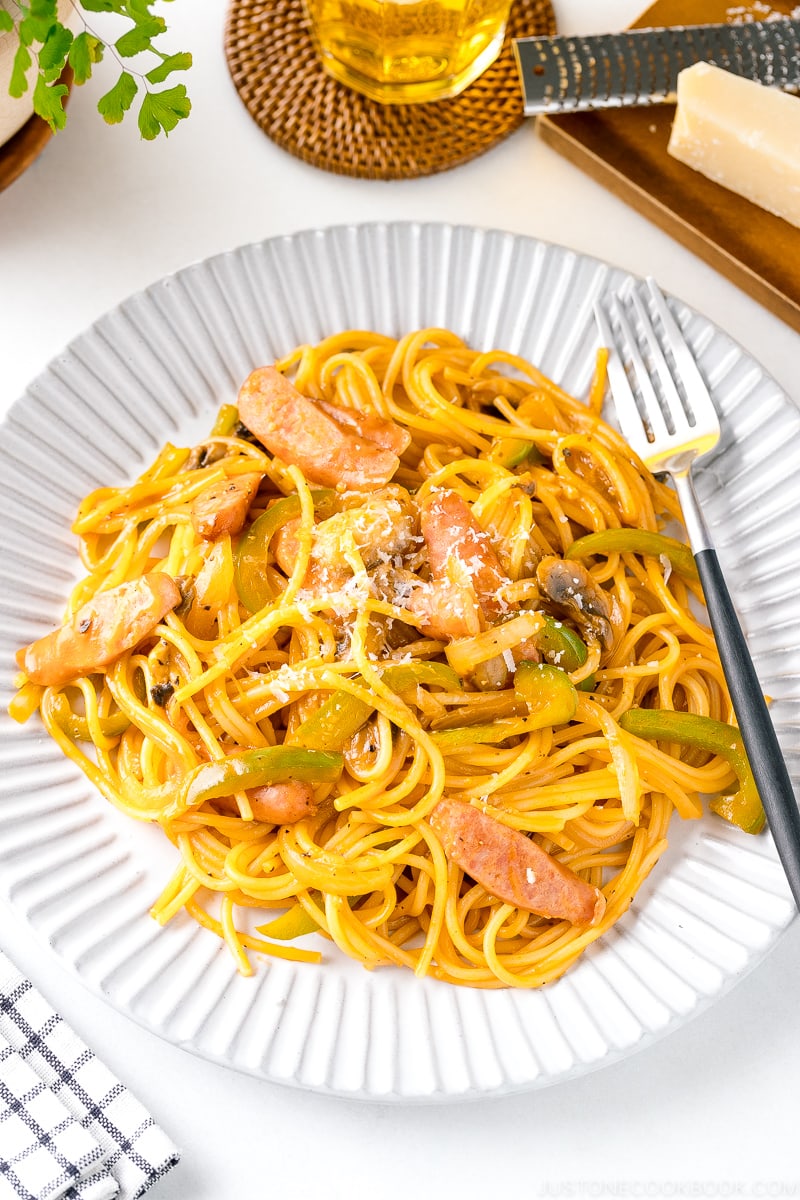
Ketchup in spaghetti?! You hear it right. The idea of spaghetti with ketchup sauce may make any Italian cringe. However, Japanese Ketchup Spaghetti, or what we call Spaghetti Napolitan (スパゲッティーナポリタン), has been a popular menu at cafe restaurants (Kissaten) since the 1950s. This comforting pasta dish always brings a nostalgic memory to many Japanese who grew up eating it.
Table of Contents
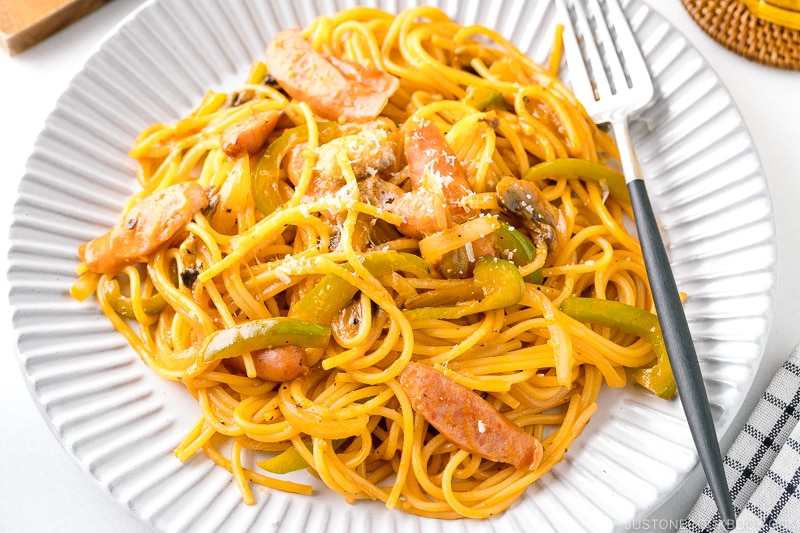
What is Napolitan?
Napolitan is tomato ketchup-based, Japanese-style pasta that consists of spaghetti noodles, onions, green bell peppers, button mushrooms, and Japanese sausages. There are a few variations where we replace the sausages with bacon or ham. However, in general, it all has a standard sunny look of appetizing orange.
Phonetically, the Japanese language doesn’t distinguish R and L as separate sounds. For that reason, it uses the same katakana characters to represent R and L sounds of Western alphabets. So we write it as either Napolitan or Naporitan. While the spelling “Naporitan” is derived from romanji (the romanization of Japanese), the spelling “Napolitan” takes the origin of the name (Napoli) into account.
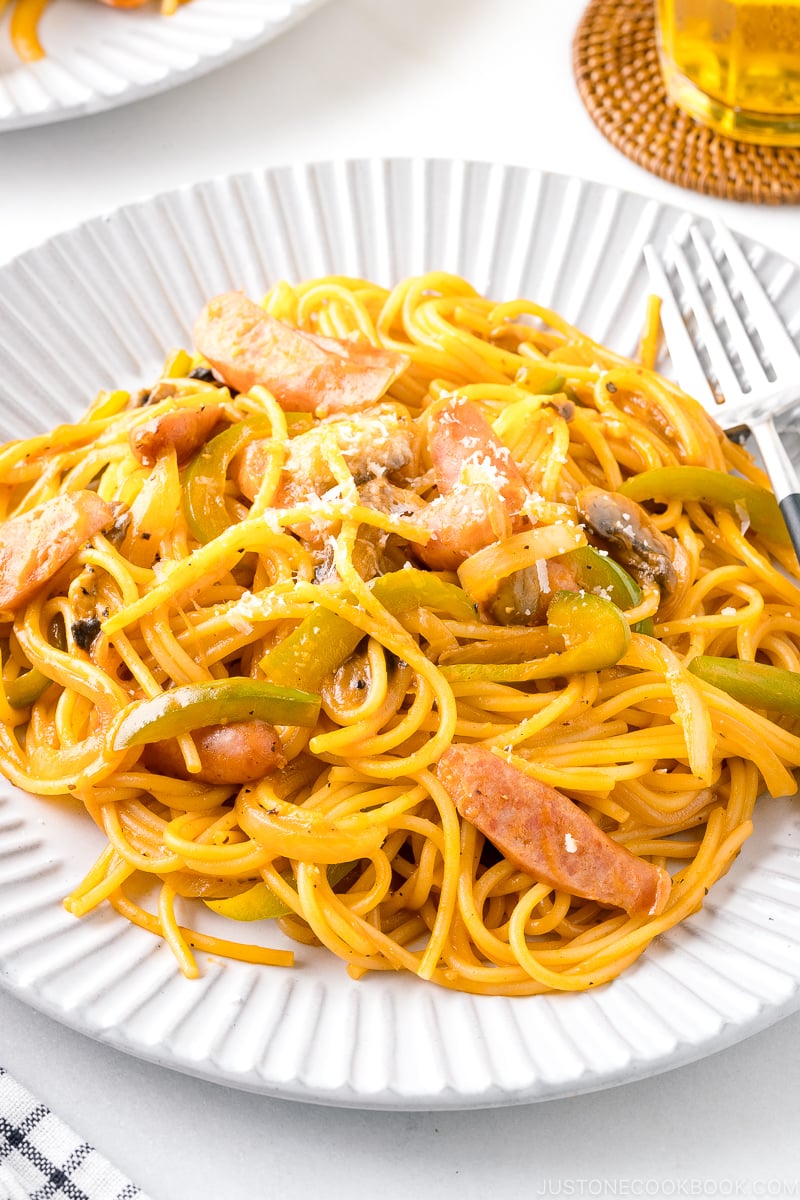
The Origin of Napolitan
There are a few theories of how Napolitan originated. The strongest theory is that it originated in Yokohama during the postwar era.
Around the 1950s, the head chef at the New Grand Hotel in Yokohama created this recipe after being inspired by the spaghetti and tomato sauce dish served to the American military. Since tomato sauce was a rare ingredient at that time, he used ketchup as a substitute for pasta sauce. He then named it “Spaghetti Napolitan”, or Napoli, after Naples, Italy.
Around the same time, Japan started to open itself to the world and began to consider fashionable new ideas from the West. These newly Westernized dishes like Spaghetti Meat Sauce and Spaghetti Napolitan received excellent responses. Eventually, they became mainstays in the cafes and Japanese home kitchens. To this day, the two dishes are still two of the most popular pasta dishes among Yoshoku (Western-influenced food, 洋食) in Japan.
Ketchup as The Key Flavoring
Not surprisingly, Japanese cuisine has used ketchup in seasoning various dishes, as this all-star American condiment lends a depth of flavor with its sweet-tangy profile.
Therefore, you can find ketchup used in Japanese Curry, Omurice, Ebi Chili, and a pasta dish like Spaghetti Napolitan. It’s a great example of how open we are when it comes to adapting other cultural influences in improving our own cuisine.
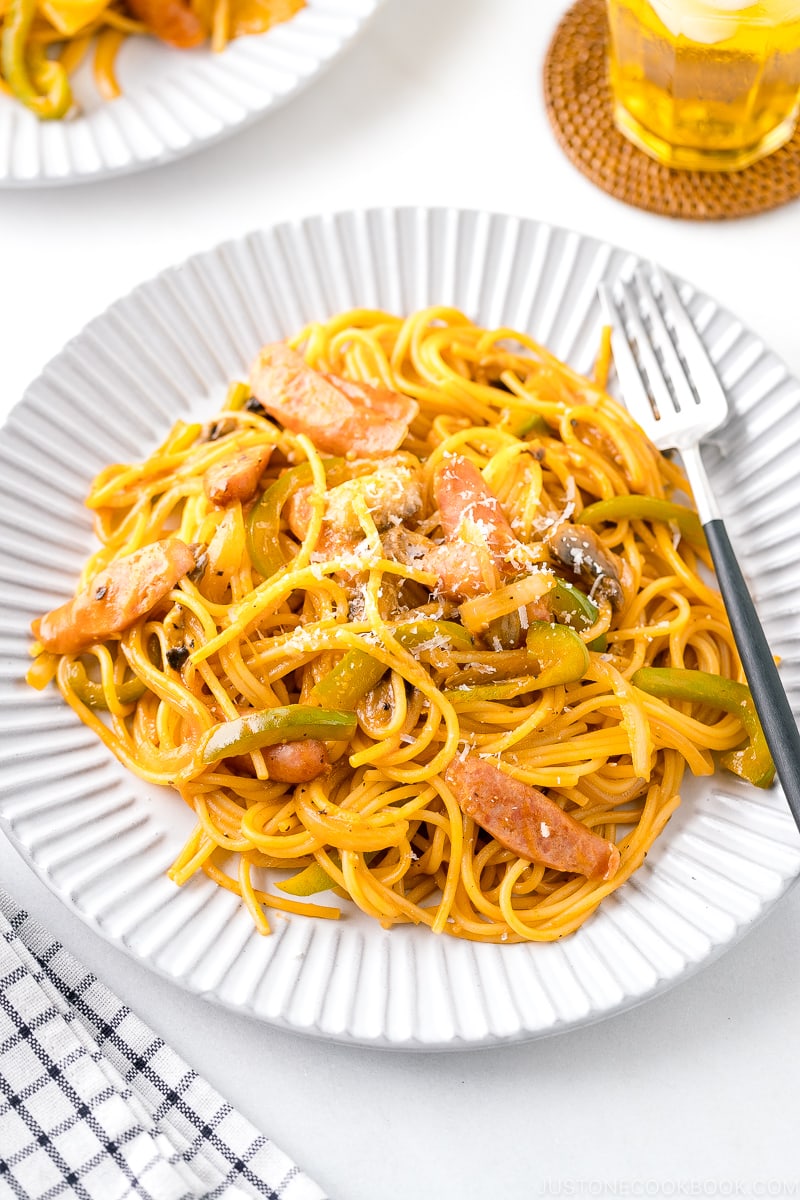
Why You’ll Love This Pasta
The genius about Spaghetti Napolitan is that it utilizes most of the pantry staples in your kitchen. The common ingredients include onion, mushrooms, green bell peppers, and sausages (ham or bacon). It’s seasoned with ketchup and Parmesan cheese and served with Tabasco sauce.
It’s really flexible, too! For example, you can try bacon in place of sausage. Likewise, use peas in place of bell peppers. Top it with a fried egg if you’d like. But simplicity is good for this recipe. When you don’t have any of the ingredients in the recipe, you can throw in whatever happens to be in season or on-hand in your kitchen.
To make it vegetarian-friendly, leave out the meat and add more mushrooms. Mix it up with a different type of mushroom for texture and flavor.
This dish is really easy to make and the flavor is kids-friendly. It makes an ideal meal for a quick dinner if you have a family with young children. I remember my son used to request this Ketchup Spaghetti when I asked what kind of pasta he would like for lunch.
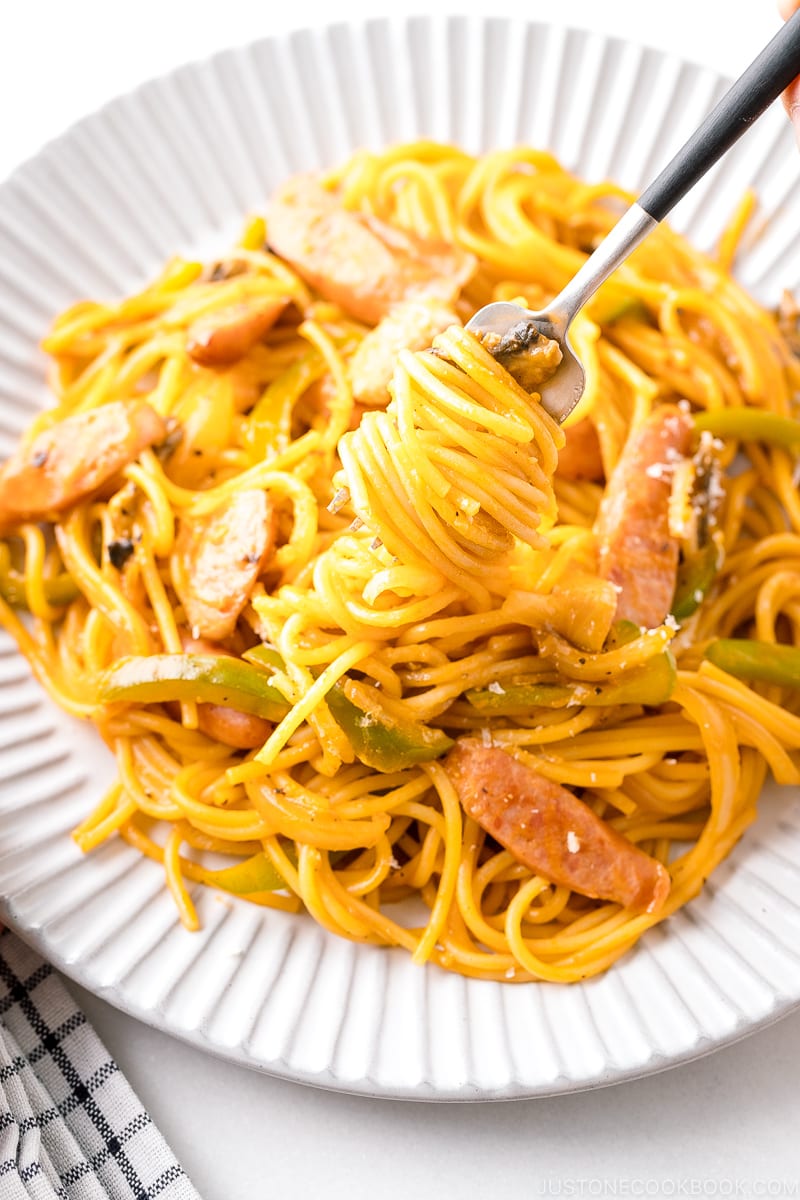
Cooking Tips
- Timing is key for a smooth workflow. Get your prep work done while you boil the water to cook the spaghetti. You should have the cooked ingredients and sauce ready by the time the spaghetti is done cooking. Then toss everything together and serve!
- The taste of ketchup slightly varies depending on the brand. I usually use this organic ketchup (No GMO ingredients, no high-fructose corn syrup) but a similar one would work great. Napolitan does have a slightly sweet taste to it, but feel free to omit the sugar as listed in the recipe. For the authentic flavor, get a bottle of Kagome Tomato Ketchup from the Japanese grocery store. It is the classic Japanese ketchup to make Omurice and Napolitan.
- Always reserve the pasta cooking water. Set aside ¼ cup (or more depending on the serving portion) of the pasta cooking water. The starch in this salty pasta water acts as a binder and creates an emulsion when you add it to a sauce that contains fat like butter or oil.
- Don’t overcook the spaghetti as you will continue to cook a bit more in the frying pan.
- Consider textures. In my opinion, this pasta dish tastes best with various textures. For veggies such as bell peppers or fresh peas or sugar snap pea, I’d keep them on the crunchy side. However, my kids do not like raw or undercooked bell peppers so they always ask them to be as thin and wilted as possible. I personally like to cook the onion a bit more (no need to caramelize) to get the sweet flavor out of it.
- Just a tablespoon of butter at the end adds umami and creaminess to the dish. So don’t skip it!
It cannot be easier to put this Spaghetti Napolitan together! For a fancy yet effortless weeknight dinner, serve it with a green salad and wine. Enjoy!
Other Japanese-Style Pasta Recipes
- Miso Butter Pasta with Tuna and Cabbage
- Creamy Mushroom and Bacon Pasta
- Ume Shiso Pasta
- Japanese-style Pasta with Shrimp and Broccolini
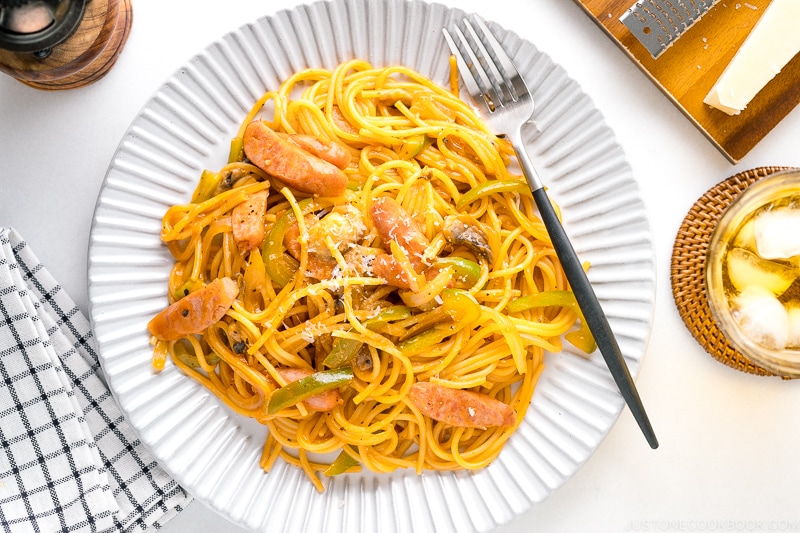
Wish to learn more about Japanese cooking? Sign up for our free newsletter to receive cooking tips & recipe updates! And stay in touch with me on Facebook, Pinterest, YouTube, and Instagram.
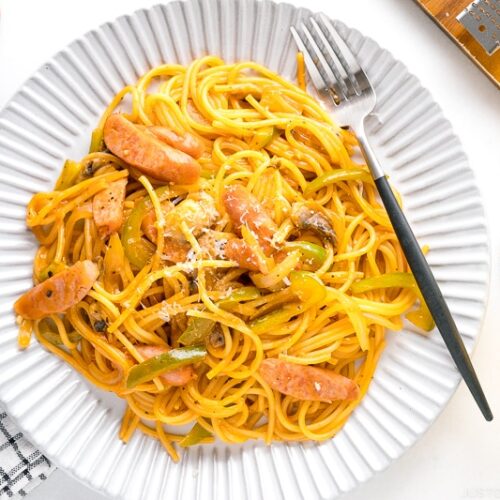
Napolitan (Japanese Ketchup Spaghetti)
Video
Ingredients
For the Sauce Seasonings
- ⅓ cup ketchup (for an authentic flavor, use Kagome Tomato Ketchup from the Japanese grocery store)
- ½ Tbsp milk (optional; for a creamier taste)
- 2 tsp Worcestershire sauce
- 1 tsp sugar (optional; for an authentic Japanese taste)
For the Sauce Ingredients
- ½ onion (3.5 oz, 100 g)
- ¼–½ green bell pepper (2.5 oz, 70 g)
- 4 mushrooms (2.5 oz, 70 g)
- 5 oz sausages (I use 4–6 kurobuta or arabiki sausages from the Japanese market; you can substitute another type of sausage, ham, bacon, etc.)
- 1 Tbsp extra virgin olive oil
- 1 clove garlic
- ¼ tsp Diamond Crystal kosher salt
- ⅛ tsp freshly ground black pepper
For the Pasta
- 7 oz spaghetti
- 1½ Tbsp Diamond Crystal kosher salt
- ¼ cup reserved pasta water (you may not need it; check your sauce and add gradually)
- 1 Tbsp unsalted butter
For Serving
- 2 Tbsp Parmigiano-Reggiano or Parmesan cheese
Instructions
- Gather all the ingredients. Start boiling a large pot of water (I use a 4 QT pot).

To Prepare the Ingredients
- In a small bowl, combine ⅓ cup ketchup, ½ Tbsp milk, 2 tsp Worcestershire sauce, 1 tsp sugar. Mix them together and set aside.

- Cut ½ onion into thin slices.

- Cut ¼–½ green bell pepper in half crosswise (if it‘s long), and then cut into thin strips.

- Cut 4 mushrooms into thin slices.

- Cut 5 oz sausages diagonally into thin slices.

To Boil the Spaghetti
- Once the water is boiling, add 1½ Tbsp Diamond Crystal kosher salt and 7 oz spaghetti. Stir to make sure the noodles don‘t stick to each other. Cook the spaghetti according to the package directions. Toward the end of cooking, reserve some pasta cooking water.While the pasta is cooking, prepare the sauce.

To Cook the Sauce
- Heat a large frying pan over medium heat. When it‘s hot, add 1 Tbsp extra virgin olive oil and distribute it evenly. Crush and add 1 clove garlic (I use this garlic press) and sauté for 1 minute, just until golden and fragrant.

- Add the onions to the pan and sauté for 2–3 minutes.

- When the onions are wilted, add the sausages and sauté for 1 minute.

- Add the bell peppers and mushrooms and sauté until everything is cooked.

- Season with ¼ tsp Diamond Crystal kosher salt and ⅛ tsp freshly ground black pepper.

- Push the ingredients to one side and add the sauce mixture to the empty side of the pan. When the sauce starts to bubble and thicken, mix it together with the sausages and vegetables.

- Now, scoop out some of the starchy cooking water from the pasta pot, about ¼ cup reserved pasta water. Remember, you may not need the reserved pasta cooking water that you saved. Add it to the pasta sauce only if it needs to loosen up. At times, I do not use it at all or use 1–2 Tbsp. Check the consistency of the sauce, and gradually add reserved pasta water, stirring well, until the sauce is the consistency you like.

- Mix it all together and let the sauce simmer and reduce a bit.

- By now, the spaghetti should be done cooking. Drain it well in a colander and add it to the pan with the sauce. Add 1 Tbsp unsalted butter and toss to combine using tongs, making sure the sauce coats the pasta evenly.

To Serve
- Serve the Napolitan immediately on individual plates. Shave 2 Tbsp Parmigiano-Reggiano or Parmesan cheese over the pasta now or at the table.

To Store
- You can keep the leftovers in an airtight container and store them in the refrigerator for 3 days or in the freezer for a month.
Nutrition
Editor’s Note: This post was originally published on Apr 19, 2013. The post has been republished with updated content, new images, and a slightly-revised recipe on July 25, 2022.
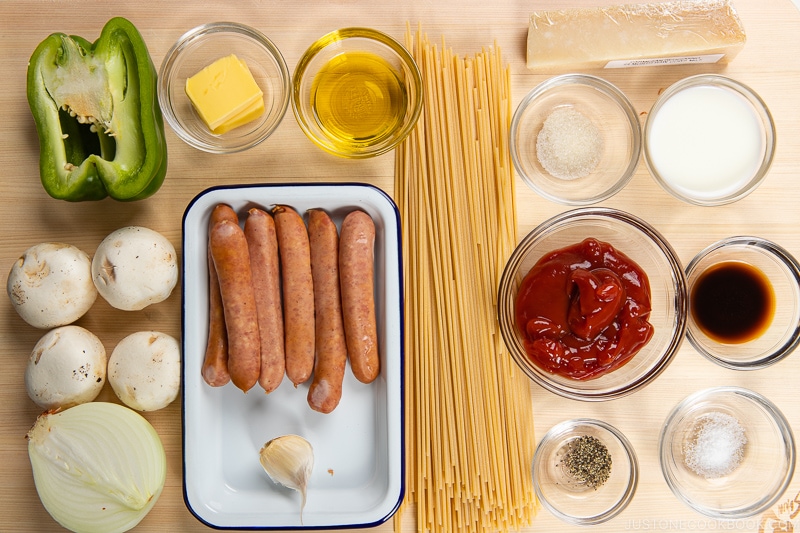
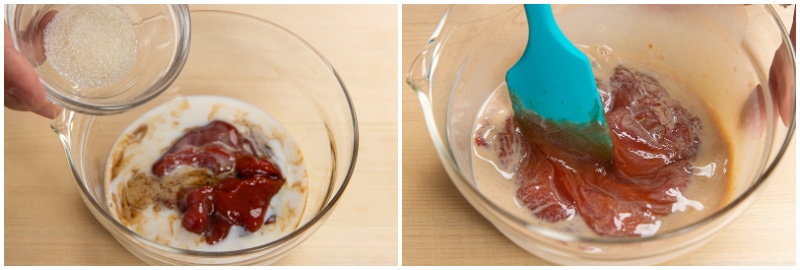
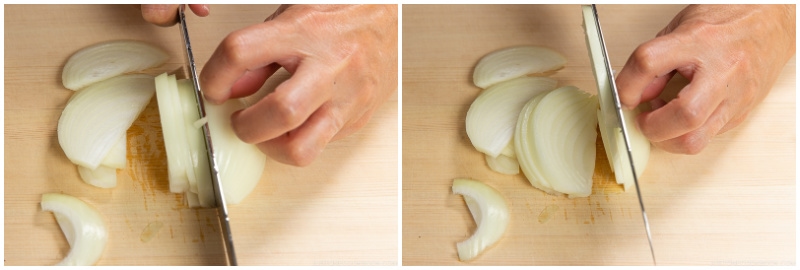
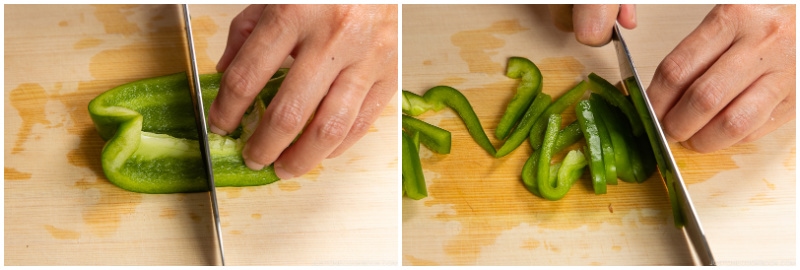
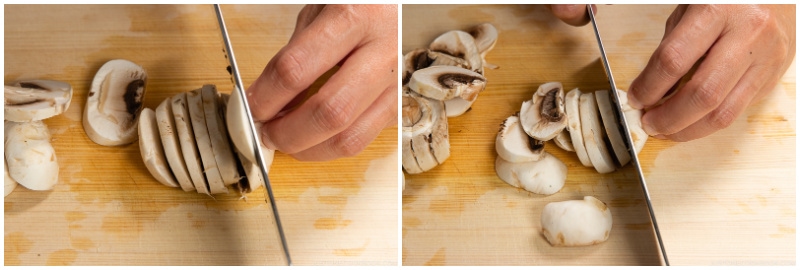
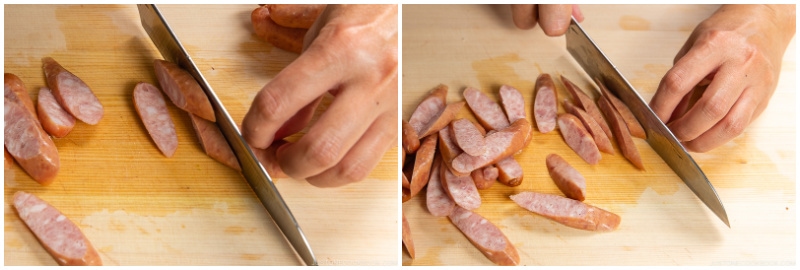
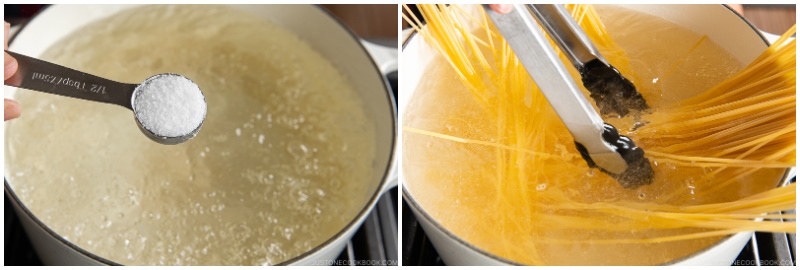
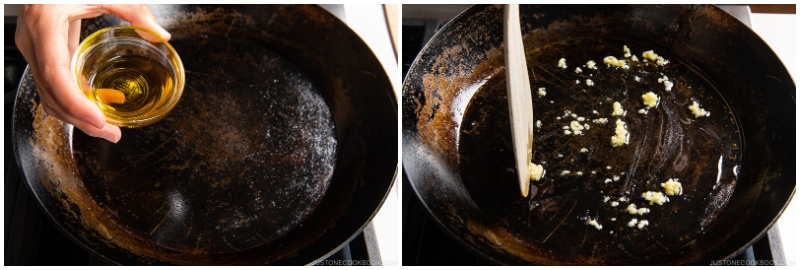
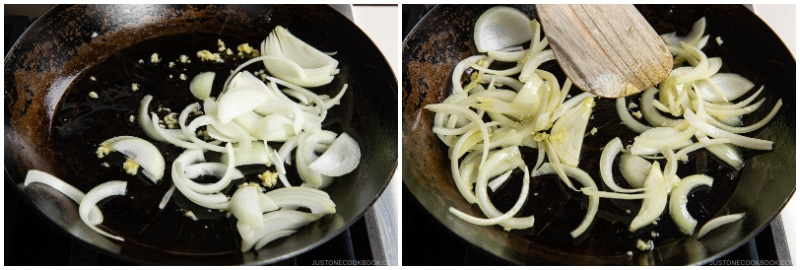
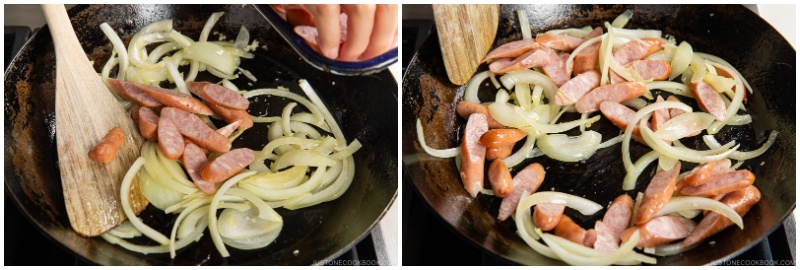
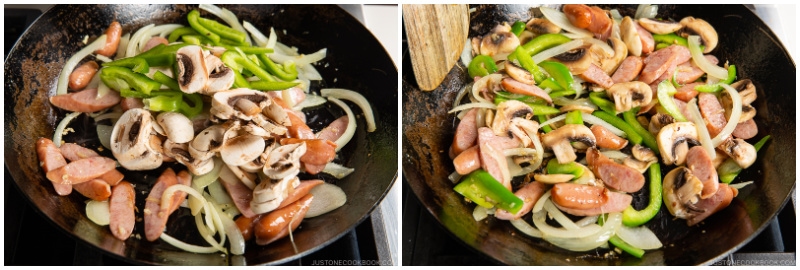
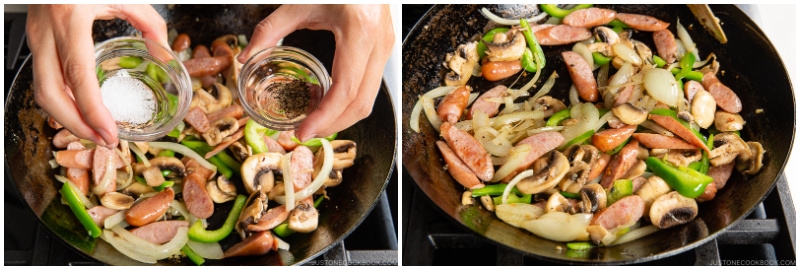
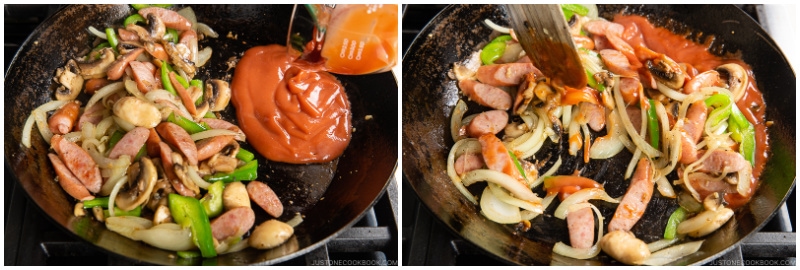
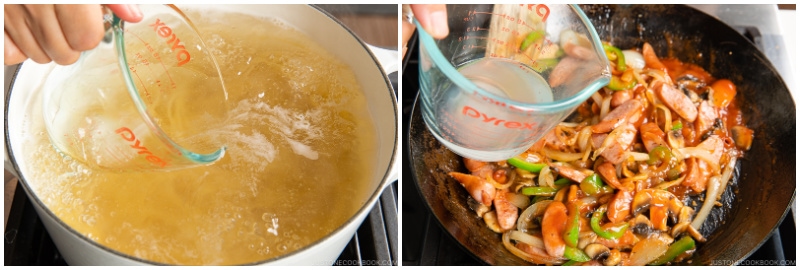
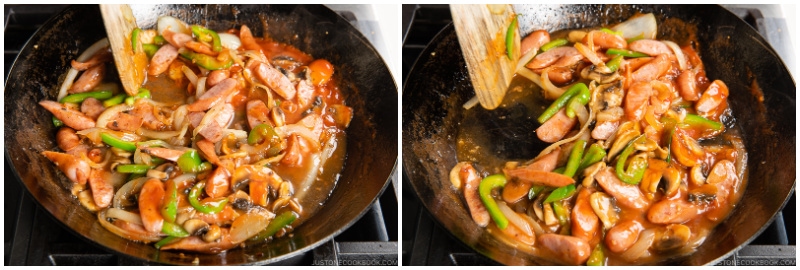
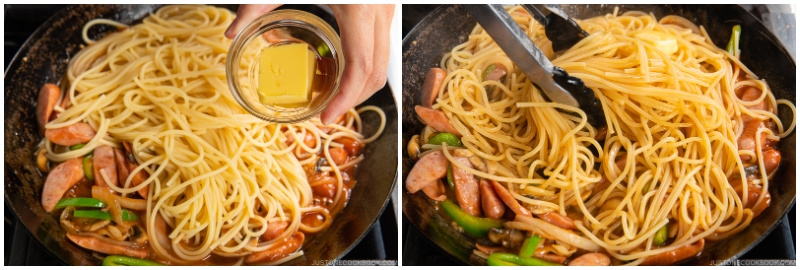
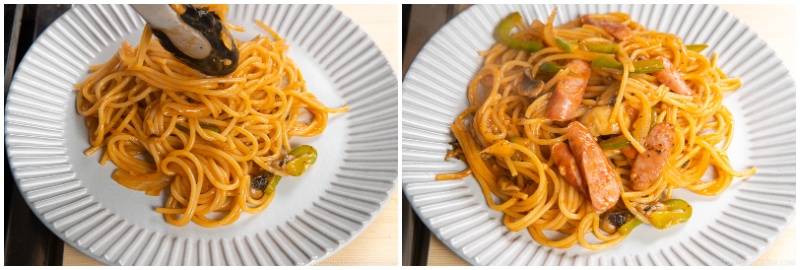










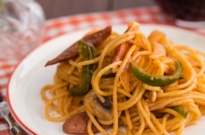
I made this tonight for dinner and it was awesome! My husband, toddler, and myself loved it. Will definitely be making it again!
Hi Summer! We are so happy to. hear you and your family loved this dish!
Thank you so much for trying Nami’s recipe and for your kind feedback.
Amazing recipe!! Tried it and loved it! Followed the recipe exactly except didn’t add the butter and parmesan cause I didn’t have it.
Hello there! Thank you so much for your kind feedback! 🥰
We are so happy to hear you enjoyed Nami’s recipe.
Saw this recipe in your recent newsletter. Hadn’t heard of it before. But, when we were kids my mom used to take our leftover Spaghetti noodles from the previous night’s dinner and fry them up in butter and then top them with ketchup for lunch the next day! The slight crunch of some of the noodles with the tanginess of the ketchup and butter flavor was quite tasty. (Although my friends always turned their noses up at it, ketchup with spaghetti?!) My mother still has no idea where she learned to make it. Now I make it on occasions for my kids. I’ll have to try this recipe to see if it has a similar flavor profile, obviously much fancier.
Hello there! Thank you for sharing your experience. It was quite touching.
We hope you enjoy Japanese Ketchup Spaghetti with your family.🤗 Happy cooking!
Amazing recipe! It came out so flavorful and thanks to the butter, perfectly rich without being too much. I added a thinly sliced Serrano pepper for a bit of spice. Will definitely make again!
Hi Shama! Thank you for your kind feedback!
We are glad to hear you enjoyed Nami’s Napolitan recipe. Happy Cooking!
Hi, I would like to try this recipe, but I have problems finding Diamond Crystal kosher salt in my country. Can I use normal table salt? Also, may I know which type of mushroom do you use?
Hi Idy, Thank you for trying Nami’s recipe!
Yes. You can use table salt. However, we recommend halving the amount in this recipe.
As for the mushroom, Nami used White button mushrooms, but you can use any type of mushroom. 🙂
We hope this helps!
I cooked this tonight and it was very well received by the family! Thank you so much for such an easy and tasty recipe 😋
Hi Idy! Thank you so much for your update!
We are so happy to hear that you and your family enjoyed Nami’s recipe! 🥰👏🏻
I made this dish before with a different recipe and it wasn’t quite what I wanted, aka same as at the local restaurants.
But now I just made it with your recipe and let me tell you: it’s so good !!!
Thank you for your hard work on this website. I’m grateful for you and the JOCB team!
P.S.
I used shiitake instead of mushrooms coz that was what I had in the fridge.
Hi Ildi! Aww.🥰 Thank you so much for trying Nami’s recipe and for your kind feedback!
Nami and all of us at JOC are so happy to hear you enjoyed Napolitan recipe!
Happy Cooking! 🤗
Great recipe! I first saw this dish in the Samurai Gourmet series. I was sure I would find the recipe in here
Hi Faith! Thank you for checking Nami’s post and trying her recipe!
We are so happy to hear you enjoyed Napolitan! 😊
Hi there – am planning to make this for my kids tonight – do you think I can sub the Worshestire sauce for soya sauce?
Hi, The Sudden Cook! Thank you for trying Nami’s recipe!
Worcestershire sauce has a tangy taste, so recommend using one teaspoon of soy sauce and 1/4 tsp lemon juice or one teaspoon of apple cider vinegar.
Another substitute will be HP Sauce.
We hope this helps!
I’m Italian and I finally made ketchup spaghetti to satisfy my curiosity. No, it doesn’t taste like ketchup on spaghetti, it tastes pretty good, it’s like a quick Neapolitan meat sauce made with Japanese methods. You can’t taste the raw ketchup, it tastes more like a tomato sauce with meat and veggies (don’t skip the Parmesan). I probably won’t do it again though, because it tastes and looks a lot like pan-reheated saucy spaghetti, AKA what happens with leftover second day pasta, which I had to eat a lot during my high school years. It just isn’t an exciting sight for me lol.
Hi Didina! Thank you very much for giving this recipe a chance and trying Nami’s recipe! 😊
I think this is going to be dinner tonight.
Instead of sausage, I’m defrosting a small portion of a large batch of wafu hambagu mix from a couple weeks ago. None of the mix so far has actually been made into wafu hambagu … instead, it’s been meatballs for pasta with pesto made from basil growing in the herb garden just out the front door; and also a small meatloaf.
(Nami’s wafu hambagu recipe, up until when you start forming and cooking the patties, hews very closely to the meatloaf / meatball archetype, and is my go-to for all those variations on the theme. Maybe I’ll do something like add some fennel or some herbs for meatballs — but often it’s just as-is.)
And for technique … relatively new to me and my new go-to method for any pasta dish that’s either finished in the pan or uses reserved water: rather than fill a large pot of water, just use enough water to cover the pasta and have a kettle of boiling water ready if you need a bit extra. Only add as much salt to the boiling pasta as you want total in the final recipe. The aim is to evaporate the water so that you only have as much as you need when the pasta is finished cooking; then you add everything else to the pan to finish the dish.
You get extra-starchy water this way for the sauce, and the results, if you’re paying close attention, come out especially velvety-smooth.
I’m likely to add a little bit of miso and a small splash of bourbon to the sauce tonight; my intuition tells me they’ll add some nice “depth” and umami. Probably a bit of garden oregano, too, come to think of it …
b&
Hi Ben! Thank you very much for sharing your cooking experience with us!
Additional Miso sounds great!😋
My mom taught me a version of this where it’s fried and crispy. I love it so much and offer it to friends when they’re around. Everyone who tries it thinks it’s delicious but a lot of the time people turn it down when they hear it’s made of ketchup. I wrote a poem about it a few years ago 😋
Ode to Ketchup Pasta
Ketchup pasta
Sometimes I think I’m the only one who likes you.
All my friends say no thanks
We do not eat pastas slathered in Heinz.
If only they would give you a try
They would know that you are delicious.
I can’t blame them.
In their shoes I might think the same.
But I would have a bite
And then change my mind.
I am torn.
Maybe I am glad they will not try just a little.
It means I can take you to work for lunch
And eat you again when I get home.
But I am still sad
Because it’s not much fun
Eating alone.
Hi Aya! Thank you very much for reading Nami’s post and sharing your story and poem!🙂
My husband hated the Japanese Del Monte ketchup we bought, so I was trying to find ways to use up. This is such a great recipe and he loves this dish! I subbed mushrooms and bell pepper for frozen mixed veggies, and they still work well. I used regular worchestershire sauce and a little bit more than the recipe suggested because I liked it a tad tangier.
Hi Xuan! Awesome! We are so glad to hear this recipe helped save the ketchup! 😃 And you and your husband enjoyed the Napolitan!
Thank you very much for trying Nami’s recipe and for your kind feedback!
One of my cookbook from Hong Kong has a recipe that has ketchup and worcestershire sauce as the main ingredient for the sauce. It is the kids’ favorite. I can already taste the spaghetti, and I can’t wait to make this tonight because I know it is going to be delicious.
Hi Elie! Thank you very much for reading Nami’s post!
We hope you enjoy Napolitan soon!😊
Great recipe. My mom who is from Kentucky used to make ketchup spaghetti. I lost her recipe over the years. This was really good! Oiishi.
Hi Tim! We couldn’t be happier to hear how much joy and excitement Nami’s recipe has brought to you!
Thank you very much for trying Nami’s recipe and for your kind feedback.